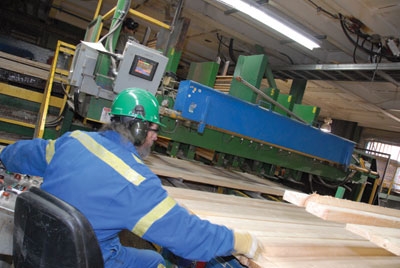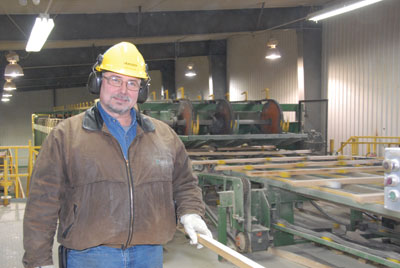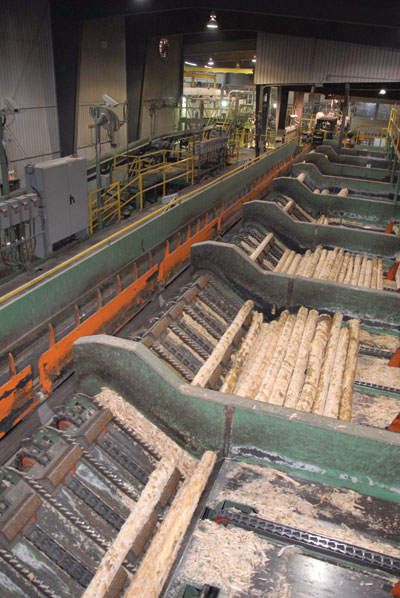
Features
Mills
Sawmilling
Strategic Sawmilling
For a sawmill to survive these days in a medium to large forest products company, it needs to deliver value to shareholders and must play a strategic role in the company’s overall plan. That’s just a fact of life for Brian Ramage, the recently appointed mill manager at EACOM Timber’s sawmill near Gogama, Ont., a small rural community situated about half way between the larger centers of Sudbury and Timmins.
November 8, 2011 By Bill Tice
 For a sawmill to survive these days in a medium to large forest products company
For a sawmill to survive these days in a medium to large forest products company
“We are primarily a stud mill and we work closely with EACOM’s 16-ft. mill in Timmins and to a lesser extent our 16-ft. mill at Nairn Centre by utilizing their residual logs,” explains Ramage as an incoming log truck loaded with cut to length wood passes over the scale that is situated just outside of his office. “The logs are separated in the woods. It’s a pretty simple process. They get the 16 footers and we get the shorter lengths. By working with the residual logs, this mill fits well within EACOM’s structure and its mandate of maximizing recovery and yield from every log.”
The Gogama mill was built in the late 1980s by Sudbury, Ont.-based William Day Construction. It was originally a single line mill featuring a HewSaw 200, 8-inch (200 mm) breakdown unit. The facility was upgraded in the fall of 2009 while part of Domtar, with a second HewSaw 200. EACOM acquired many of Domtar’s Ontario and Quebec sawmill assets in 2010, including the Gogama mill.
Upgrades
Today, with both HewSaw lines operating on two shifts, the mill can produce about 100 million BF of lumber per year. Ramage says most of that product is 2×4 studs up to 8 ft. in length, but he adds they will also run 2×3 and 2×6 products along with some 1×3 and 1×4. He notes that the one-inch product is more of a recovery item that lets the mill secure more value out of the logs. “Typically we are dealing with a 5-inch log profile so we can get a couple of 2x4s and some 1-inch product out of each log,” he explains. “With the right size log going through our HewSaw machines this mill is very efficient, can produce an excellent product, and can run at a good pace day-in and day-out.”
Later this year, the mill is upgrading the infeed into the newer HewSaw with a new rotary log positioner that will be built and supplied by HewSaw. Until now, the Number 2 line featured what Ramage calls a “banana” or “belly pan” infeed. “It feeds horns up,” he explains of the older infeed system. “But with the speed we are running and the log shape we are dealing with, we aren’t always guaranteed the best log orientation.”
The new HewSaw log positioner is designed to fix the problem, as two rotating elements will pick-up the log after it is scanned by equipment from Saint-Georges, Que.-based Prologic+. “This should improve our recovery,” says Ramage, while adding that they expect the 10-day installation to be completed this summer. The Prologic+ technology provides 3-D scanning with optimization and positions the log for the best recovery. The scanning system selected for this project is from Hermary Opto Electronics, of Coquitlam, B.C., and includes a 3 head scan zone of Hermary’s SL-1880, Sheet of Light Scanner.
Mill Flow
The mill flow at the Gogama facility starts in the log yard where two Caterpillar 980 loaders with power lifts unload the incoming log trucks and then hot load the mill if possible, or place the logs in inventory for later use. Ramage says in most cases, it’s inventory as the logs need to be sorted by species. As for size, everything coming in to the mill is cut in the woods to 102 inches.

The mill has two log decks where the 980s deposit the logs when they are ready for processing. Ramage says these are essentially bins and each bin has a wave feeder that takes the logs to one of two Nicholson A5 debarkers. After the debarkers, there are another eight bins, which hold the logs until the HewSaws are ready for them. What the mill staff calls “Line One” is the older HewSaw 200, while “Line Two” is the HewSaw 200 that was installed in 2009. This is also the line that will receive the new log positioner.
Both lines have a common Coe (now USNR) unscrambler and trimmer, which is followed by a drop out gate that will send any product that needs remanufacturing to a specially designed reman machine from Hollins Industries in 100 Mile House, B.C. “The reman machine does the job of taking 2x4s and remaning them down to 1x4s or 2x3s,” adds Ramage. “The reman machine was built specifically for this mill and it is a pocket machine that works on knives, rather than saws.”
Finally, the mill has a sorting line with a Newnes (now USNR) 20-bin sorter and a stacker with automatic stick placement.
Kilns and the Planer
The mill doesn’t have any kilns or planer equipment, so at this point, most product is shipped to EACOM’s Nairn Centre mill for further processing. Ramage says a small amount of wood will go out rough and green from Gogama, but most of the wood will makes the approximately 200 kilometre trek by truck to the Nairn Centre mill. Once on site, the rough lumber will be put into inventory or loaded straight into one of three older model kilns, two of which run on hot oil and one that uses natural gas.
Once dry, the lumber is sent trough Nairn Centre’s Newmann Whitney 712 planer, followed by a recently installed automatic, in-line defect grading system from VAB Solutions in Quebec, City, Que. Next in line at Nairn Centre is a trimmer, sorter and stacker, all from the former Gemofor company.
With the drying and finishing activities taking place off site, quality control at the Gogama mill is very important so supervisors do regular size measurements, chip sampling and other QC checks. Right now the Gogama mill is running on two shifts and employs about 45 people, including management. As for going to three shifts if the lumber markets improve, that may be difficult due to the mill’s remote location.
“Our biggest challenge is attracting employees,” concedes Ramage. “The mill is fairly remote and quite a ways from Timmins and Sudbury and that really presents a problem for us. We do have the community of Gogama about 50 kilometres from the mill and the company owns a small trailer court nearby where many employees stay during the week and then head home on the weekends.”
Another solution for the mill’s housing shortage is in the works as the company is working to have an apartment available to employees in the town of Gogama. They expect the fully renovated apartment to be ready in the late spring and hope it will appeal to out-of-town employees wanting to work at the mill.
When it comes to safety, Ramage says the mill is doing well. “We will hit three years recordable free in February,” he says. “It really comes down to employee awareness and everyone looking out for each other. At EACOM, having an excellent safety program is a corporate mandate and value and that is embraced by the employees.”
Looking down the road, the Gogama mill should continue to play a strategic role in EACOM’s plans, especially when the lumber markets eventually improve and the company’s two neighboring 16-ft. mills ramp up production to capacity and send even more residual logs in Gogama’s direction.
Print this page